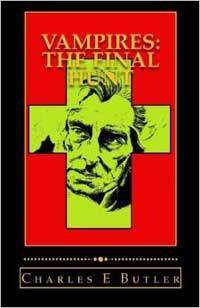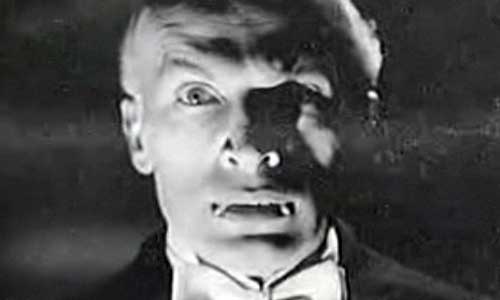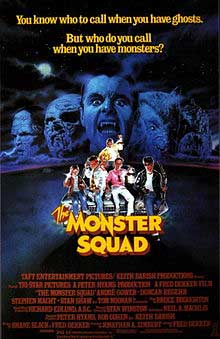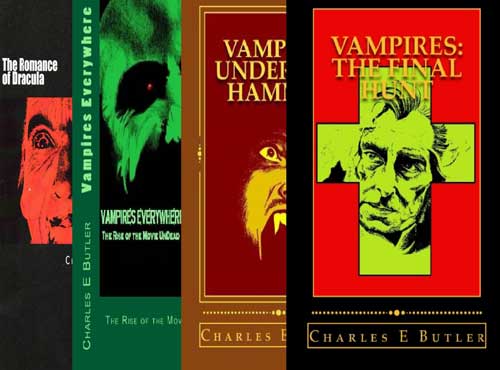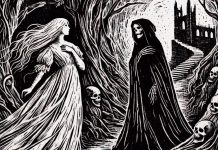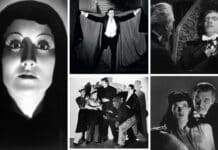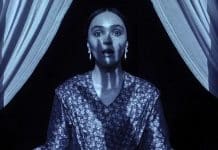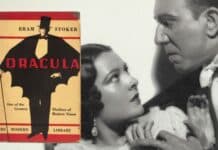In this exclusive extract from CHARLES E. BUTLER’S new book, Vampires: The Final Hunt, he discusses cinema’s generally unsuccessful attempts to create Dracula film adaptations
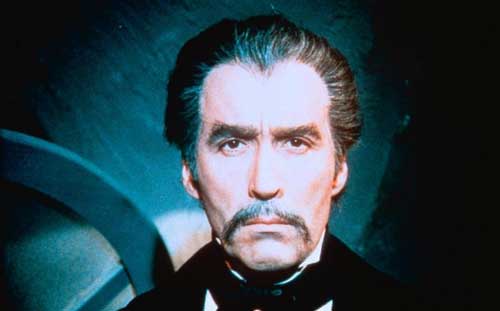
Dracula had never been more popular in straight adaptations in any other decade than in the 1970s.
Sir Christopher Lee had begun the ball-rolling in Jess Franco’s clunky El Conde Dracula/Bram Stoker’s Count Dracula (1970).
This ‘faithful’ Spanish adaptation left a lot to be
Jack Palance starred in the Dan Curtis TV production Bram Stoker’s Dracula (1973) to great success and the film was released theatrically.
Palance imbued the Count with humanity and the savagery that was the Stoker trademark.
Using the loose connection to the historical Vlad Dracula of Transylvania for the second time – the first hints had been engineered in Drakula Istanbul’da (1953) – Richard Matheson’s screenplay brought depth to a formula that had run its course at Hammer films.
1978 and 1979 saw the releases of Philip Saville’s Count Dracula; a Gothic Romance, with Louis Jourdan and John Badham’s Dracula starring Frank Langella.
Both versions concentrated on the sex-appeal of the monster touched upon by Hammer films and the performance of Christopher Lee.
Bram Stoker’s Count was missing in both productions, but the Jourdan movie is still the closest attempt to
In Germany, Werner Herzog acknowledged the master, FW Murnau, in his attempt to re-film scenes from the classic
Kinski gives perhaps the most unique performance of the king vampire on film.
But, like Max Schreck before him, the eventual movie has all the earmarks of being a curious, one-shot production whose sequel, Nosferatu; Vampire in Venice (1988), shares nothing in common with the original save for the recasting of Kinski – this time with hair – and a more convoluted plot featuring added sex and gore.
Fuelled with nothing but frustration, film makers stopped adapting the book – a feat that I personally believe is impossible – and from the 1940s onwards, the public had flocked to the cinema to see the less discerning, and, in many cases, more entertaining Dracula movies that didn’t even show Dracula, but had the king vampire’s image or name appended to the production to add extra notoriety.
Beginning really with The Return of the Vampire (1944) as Bela Lugosi turns in a better film than Dracula under the direction of Lew Landers (Louis Friedlander). Landers also directed the star in this author’s own favourite Lugosi film The Raven (1935).
John Abbott starred in The Vampire’s Ghost (1945) that faithfully replayed elements from John Polidori’s novel, The Vampyre.
The 1950s brought us the scientifically spawned vampires such as The Thing From Another World (1951) and John Beal in The Vampire (1957).
German Robles appeared as Count 58 Karol de Lavud in the Mexican movie El Vampiro/The Vampire (1957) and its sequel El Ataud del Vampiro/The Vampire’s Coffin (1957).
Both of these movies were fashioned before Hammer studios began their own reshaping of the myth and El Vampiro in particular seems more at home emulating the successes of Universal studios.
The well-kept crypts in both films also acknowledging Drakula Istanbul’da!
When Francis Lederer rose from his smoke-filled coffin amongst the alien bloodsuckers that roamed the universe, the Count was quickly becoming The Fantastic Disappearing Man, but the film was optimistically renamed The Return of Dracula (1957).
The end of the fifties saw the real beginning of all kinds of doppelgangers and pretenders to the Count’s throne in Spain, Italy, France and, most prolific, Mexico!
German Robles starred in a 12 part series, La Maldicion De Nostradamus/The Curse of Nostradamus (1958) that was suitably re-edited into four movies in 1960.
Robles is the descendant of the 16th century prophet Michel De Nostradame (1503-1566) and a vampire complete with beard and a hunchback sidekick!
The four movies edited together from the
Would-be usurpers for the crown of the King of the undead include, Christopher Lee’s own Baron Roderigo de Frankurten in Tempi Duri Per I Vampire/Uncle Was a Vampire (1959) and Hammer film’s sub-Counts, the Baron Meinster of Brides of Dracula (1960) and Dr Ravna holding midnight
Further usurping in the sixties was tried by El Baron Brakola (1968), defeated after a few fast folds with the cinematic wrestling legend Santo; the Count Kernassy, (Playgirls and the Vampire; 1963), and the ever popular Count Von Krolock, (Dance of the Vampires/The Fearless Vampire Killers; 1967)!
El Imperio De Dracula/The Empire of Dracula (1966), had proved to be nothing more than a rehash of Hammer’s Dracula, Prince of Darkness the previous year, with the lead vamp answering to the moniker of Count Draculstein! Michael Rennie, perennial space traveller from The Day the Earth Stood Still, revived all the monsters including Dracula for the leaden El Hombre que Vino Del Ummo/Dracula vs Frankenstein (1969)
Filmed across Spain, West Germany and Italy, this would prove to be Mr Rennie’s last movie.
Dracula himself was relegated to a slew of dire comedies and soft and hardcore porn features that took him into the mid-seventies.
Titles like Dracula, the Dirty Old Man, Dracula’s Great Love, Dracula’s Great Lust, Spermula, Dracula’s Vampire Lust and leading to the inevitable Dracula Sucks!, had turned the Count into an undead hobby horse ridden by everyone. Count Yorga, Vampire (1970) and Blacula (1971), were the most high profile imposters to hit the screen.
Both held impressive vampire attacks, but failed to last the course of more than two films – although Yorga star 60 Robert Quarry would pin The Deathmaster (1972) to his CV for good measure.
David Niven and Ferdy Mayne had done the Count little service in the crass Old Dracula/Vampira (1974) and the ridiculous The Vampire Happening (1971).
Deafula (1975) wasn’t the adaptation that its title suggests and, like Blacula, adds another name-dropping progeny to the ever-extending roster.
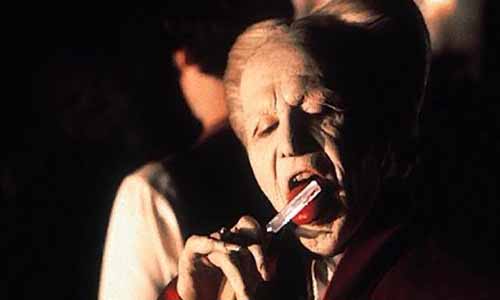
Even Christopher Lee’s second pop at revitalizing his image in the French whimsy, Dracula Pere et fils/Dracula, Father and Son (1977), slipped by almost unnoticed.
In 1979 Frank Langella and Klaus Kinski were beaten back at the box office by the cheeky George Hamilton draining the vein in the satirical Love At First Bite.
The small screen introduced Richard Lynch in Vampire (1979) clawing his way out of the grave as the cross of San Francisco fries his resting place.
Anton Voytek makes a memorable killer, and Reggie Nalder roared his way to the top of the TV heap as Kurt Barlow, staking his claim as the most frightening upstart yet to put in a bid for the throne of the King of Vampires in the imaginative two-parter, Salem’s Lot!
In 1980, the Count was unofficially pronounced dead with films proffering Dracula’s Last Rites.
The better film of the whole decade coming in the shape of Lake of Dracula (1971) one of three films directed by Michio
There would be no serious attempt to put the Bram Stoker novel
The eighties concentrated on fandom and the release of video spawned new characters invented by fans of the classics, the regular slew of Fright Night, The Lost Boys, Near Dark and Vamp, overshadowed relatives of the Count making much headway like Sylvia Kristel in Dracula’s Widow (1988).
Japan tried to raise him from obscurity using sketchy animation techniques in cartoons like Tomb of Dracula; Sovereign of the Damned (1980) based on the excellent Marvel comic book sequel and Vampire Hunter D (1985) made his enigmatic debut.
Only one appearance of the Count really stands out in the eighties, Duncan Regehr exuded real menace as Dracula in the schoolboy romp The Monster Squad (1987) and was aided by a knowing script and great Stan Winston effects conjuring up a werewolf, Frankenstein’s monster, a mummy and the Creature from the Black Lagoon.
Moving forward to the nineties and films like Subspecies, Project Vampire, Moonrise/My Grandpa is a Vampire-with Al Lewis revamping his old role from The Munsters – Fran Rubel Kuzui’s Buffy The Vampire Slayer and later, the hip Maximillian, Eddie Murphy, strutting his stuff as The Vampire in Brooklyn (1994), it was a daring feat for the Count to come out of hibernation in Bram Stoker’s Dracula, with Gary Oldman’s Prince Vlad trying to reclaim his crown as the undisputed Lord of the undead!
Successful as this film was, it left a bad taste in the mouth and was immediately lampooned by Mel Brooks in Dracula Dead and Loving It (1995).
The new Millennium began very promising with Dracula’s Curse (2002), this TV two-parter held a great Count in Patrick Bergin’s lecherous homosexual, and the title was only changed to Dracula on the DVD release, while the high-profile BBC TV movie Dracula (2006) with Marc Warren has all but vanished from memory.
As we nestle tentatively into what is known as the 21st century, we witness the Count being unceremoniously dragged back to his fabricated roots in TV epics like Dracula; the Dark Prince (2000), with Rudolph Martin carrying on the character after his unmemorable turn in television’s Buffy the Vampire Slayer (season 5 Ep.1).
Jonathon Rhys Meyers starred in a short-lived NBC production – Dracula (2013) – and after a promising wait, Universal’s super hero themed reboot, Dracula Untold (2014), was a lucrative money-spinner, but a disappointment for many fans.
The last real Dracula adaptation to be screened is still the Francis Ford Coppola reworking.
Love it or hate it, it had the power to elevate The Count to the top of the tree again proving that you can’t keep a good man down.
What is your favourite Dracula film adaptation? Tell us in the comments section below!


